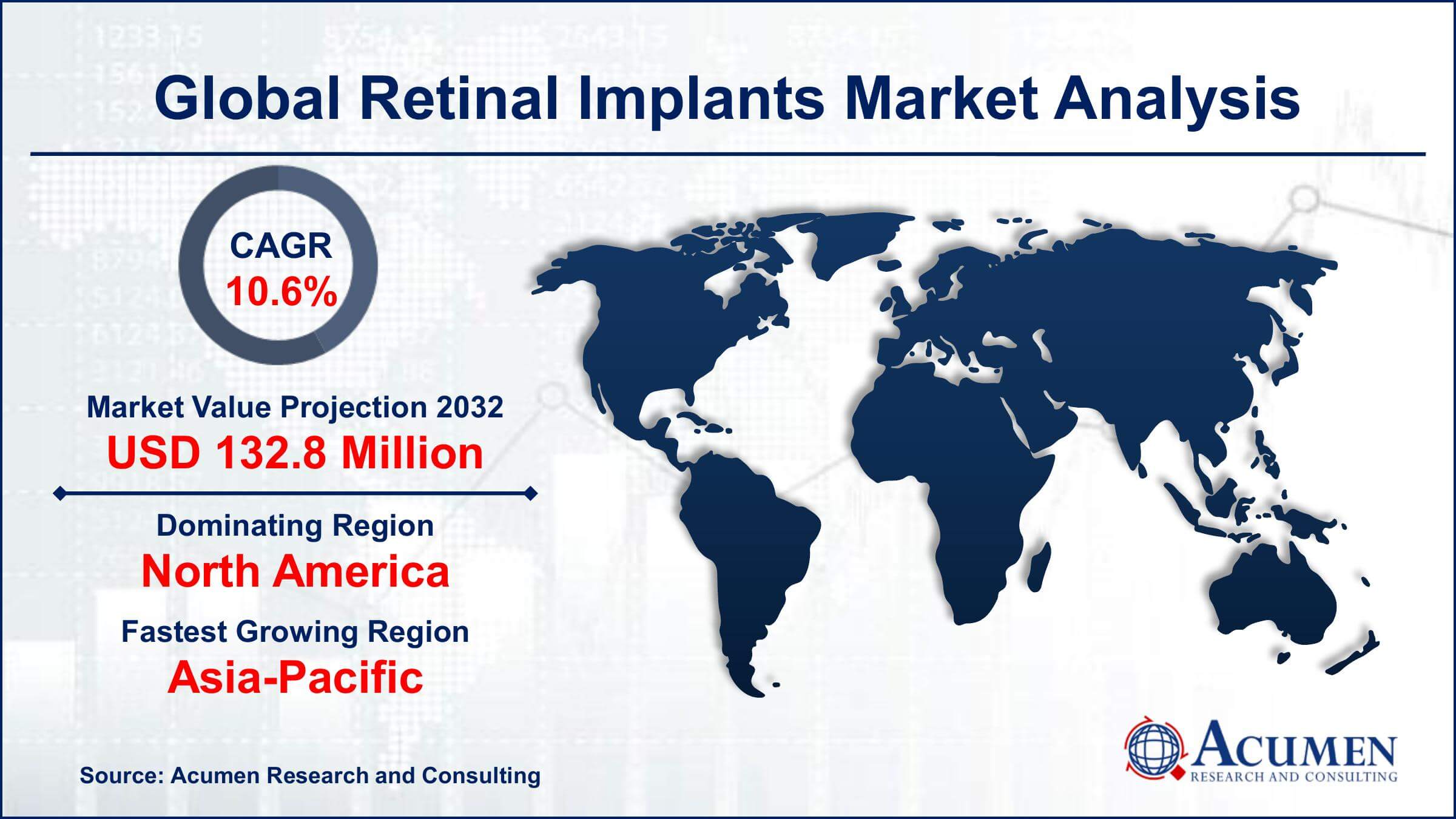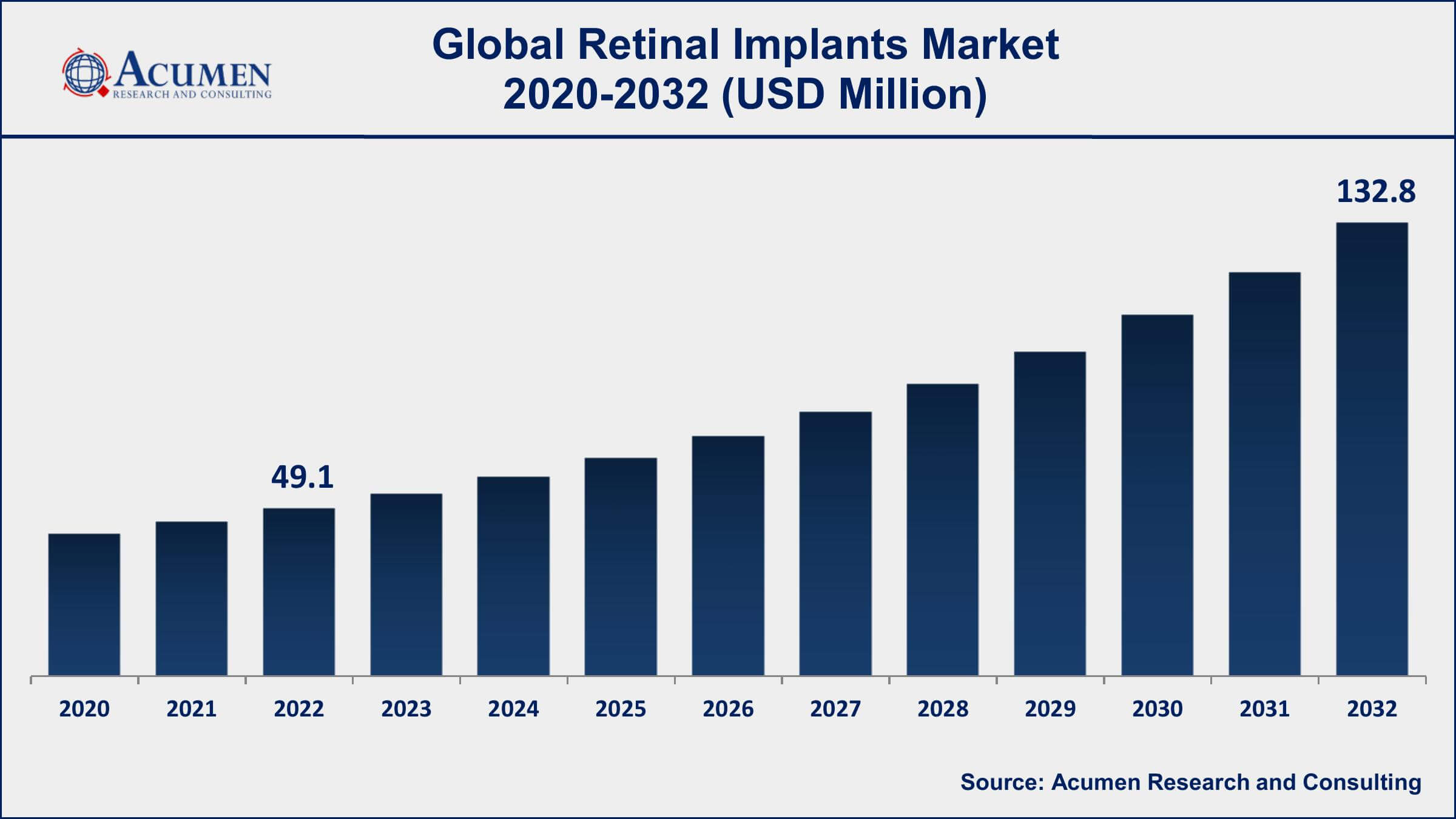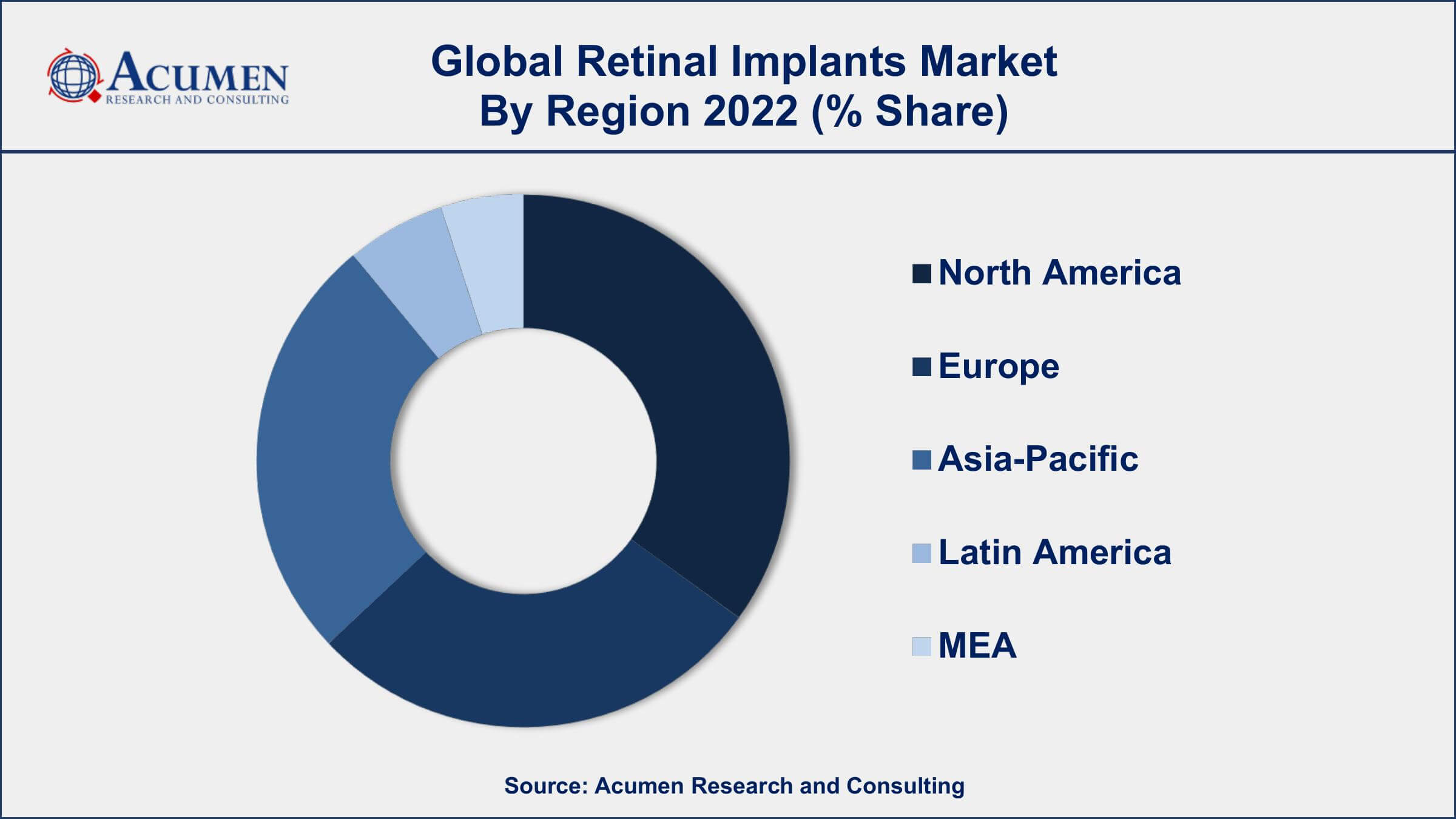March 2024
Retinal Implants Market Size accounted for USD 49.1 Million in 2022 and is projected to achieve a market size of USD 132.8 Million by 2032 growing at a CAGR of 10.6% from 2023 to 2032.
The Global Retinal Implants Market Size accounted for USD 49.1 Million in 2022 and is projected to achieve a market size of USD 132.8 Million by 2032 growing at a CAGR of 10.6% from 2023 to 2032.
Retinal Implants Market Key Highlights

Retinal implants are innovative medical devices designed to restore partial vision to individuals who have experienced severe vision loss due to conditions like retinitis pigmentosa or age-related macular degeneration. These implants work by directly stimulating the remaining healthy cells of the retina or the optic nerve, bypassing damaged photoreceptor cells. Essentially, they convert light into electrical signals that the brain can interpret, allowing individuals to perceive patterns of light and objects.
The retinal implants market has been experiencing significant growth in recent years due to an increasing prevalence of vision-related disorders and the growing demand for advanced treatment options. As the global population ages, the incidence of age-related macular degeneration and other retinal diseases is on the rise, driving the need for effective solutions. Moreover, ongoing advancements in technology and medical research have led to improvements in the performance and accessibility of retinal implants. These factors, combined with a greater focus on healthcare and a rising awareness of visual impairment issues, are contributing to the expansion of the retinal implants industry.

Global Retinal Implants Market Trends
Market Drivers
Market Restraints
Market Opportunities
Retinal Implants Market Report Coverage
| Market | Retinal Implants Market |
| Retinal Implants Market Size 2022 | USD 49.1 Million |
| Retinal Implants Market Forecast 2032 | USD 132.8 Million |
| Retinal Implants Market CAGR During 2023 - 2032 | 10.6% |
| Retinal Implants Market Analysis Period | 2020 - 2032 |
| Retinal Implants Market Base Year |
2022 |
| Retinal Implants Market Forecast Data | 2023 - 2032 |
| Segments Covered | By Device Type, And By Geography |
| Regional Scope | North America, Europe, Asia Pacific, Latin America, and Middle East & Africa |
| Key Companies Profiled | Abbott, IMI Intelligent Medical Implants AG, Boston Retinal Implant Project, Bionic Vision Technologies, VisionCare, Inc., Pixium Vision, Visus Technology, Inc., Nano Retina, Cicor Management AG, Second Sight Medical Products, Inc., Labtician Ophthalmics, Inc., and Koninklijke Philips N.V. |
| Report Coverage |
Market Trends, Drivers, Restraints, Competitive Analysis, Player Profiling, Covid-19 Analysis, Regulation Analysis |
Retinal implants are cutting-edge medical devices designed to address severe vision loss in individuals suffering from retinal degenerative diseases such as retinitis pigmentosa and age-related macular degeneration (AMD). These devices are surgically implanted into the eye and function as artificial retinas, serving to partially restore vision in patients whose photoreceptor cells, responsible for detecting light, have deteriorated. Retinal implants work by capturing external visual stimuli and converting them into electrical signals that stimulate the remaining functional retinal cells or the optic nerve. These signals are then transmitted to the brain, allowing the patient to perceive patterns of light, shapes, and even some degree of object recognition.
The applications of retinal implants are primarily focused on providing vision enhancement and improvement in the quality of life for individuals with severe visual impairments. While they do not restore normal vision, retinal implants offer a means for patients to regain some level of visual function, allowing them to recognize obstacles, navigate their surroundings, and potentially engage in activities they may have found impossible before. The application of retinal implants holds immense promise in enabling greater independence and autonomy for visually impaired individuals, enhancing their ability to perform daily tasks, and potentially improving their overall well-being. Ongoing advancements in implant technology and continued research in this field aim to further expand the scope of applications and improve the effectiveness of retinal implants in the future.
The retinal implants market has been experiencing substantial growth in recent years, primarily driven by several key factors. One of the primary drivers is the increasing prevalence of age-related macular degeneration and retinal diseases, which are becoming more common as the global population ages. These conditions often lead to severe vision loss, spurring demand for innovative solutions like retinal implants that can restore partial vision and improve patients' quality of life.
Advancements in retinal implant technology have also played a crucial role in market growth. Ongoing research and development efforts have led to improved implant designs and performance, making these devices more effective and accessible to a broader patient population. Furthermore, the rising awareness of visual impairment issues, coupled with a growing focus on healthcare, has contributed to increased adoption and acceptance of retinal implants as a viable treatment option. As a result, the retinal implants market is expected to continue its expansion, with opportunities for further innovation and market penetration as technology and accessibility continue to improve. However, challenges such as the high cost of procedures and ethical considerations related to the technology's use must also be addressed as the market evolves.
Retinal Implants Market Segmentation
The global Retinal Implants Market segmentation is based on device type, and geography.
Retinal Implants Market By Device Type
In terms of device types, the implantable miniature telescope (IMT) segment accounted for the significantrevenue share in 2022. This innovative device is designed to improve vision in patients suffering from end-stage age-related macular degeneration (AMD), where central vision is severely compromised. The IMT is implanted into the eye to magnify images and project them onto healthier parts of the retina, effectively expanding the patient's field of vision. This unique approach has garnered significant attention in the ophthalmology field. One of the key drivers behind the growth of the IMT segment is the increasing aging population worldwide, as AMD is more common in older individuals. As the demographic of elderly individuals expands, so does the pool of potential IMT candidates, creating a larger market for these devices. Additionally, as clinical trials and real-world evidence continue to demonstrate the efficacy of IMTs in improving visual outcomes and quality of life for AMD patients, more ophthalmologists and healthcare professionals are recommending and performing these procedures. This growing acceptance and positive patient outcomes are contributing to the expansion of the IMT segment within the market.
Retinal Implants Market Regional Outlook
North America
Europe
Asia-Pacific
Latin America
The Middle East & Africa

Retinal Implants Market Regional Analysis
Geographically, North America has been a dominating region in the retinal implants market for several reasons. First and foremost, North America boasts a robust healthcare infrastructure with advanced medical facilities and a high level of technological innovation. This environment fosters the development, approval, and adoption of cutting-edge medical technologies like retinal implants. Regulatory agencies such as the U.S. Food and Drug Administration (FDA) have been relatively proactive in approving retinal implant devices, ensuring their availability for patients in need. Another significant factor contributing to North America's dominance in the retinal implants market is the region's substantial investment in medical research and development. The United States, in particular, is home to numerous leading ophthalmology and medical research institutions, fostering a culture of innovation in eye-related medical technologies. This research prowess has led to the development of advanced retinal implant technologies, attracting both domestic and international patients seeking innovative solutions for vision restoration. Furthermore, North America's relatively high healthcare spending and the presence of robust health insurance systems make retinal implant procedures more accessible to a broader patient base.
Retinal Implants Market Player
Some of the top retinal implants market companies offered in the professional report include Abbott, IMI Intelligent Medical Implants AG, Boston Retinal Implant Project, Bionic Vision Technologies, VisionCare, Inc., Pixium Vision, Visus Technology, Inc., Nano Retina, Cicor Management AG, Second Sight Medical Products, Inc., Labtician Ophthalmics, Inc., and Koninklijke Philips N.V.
Looking for discounts, bulk pricing, or custom solutions? Contact us today at sales@acumenresearchandconsulting.com
March 2024
March 2025
March 2021
November 2024